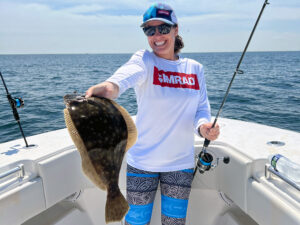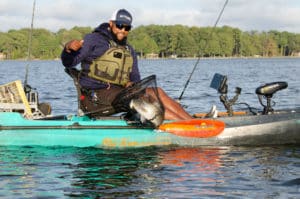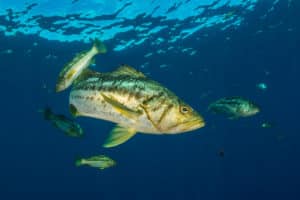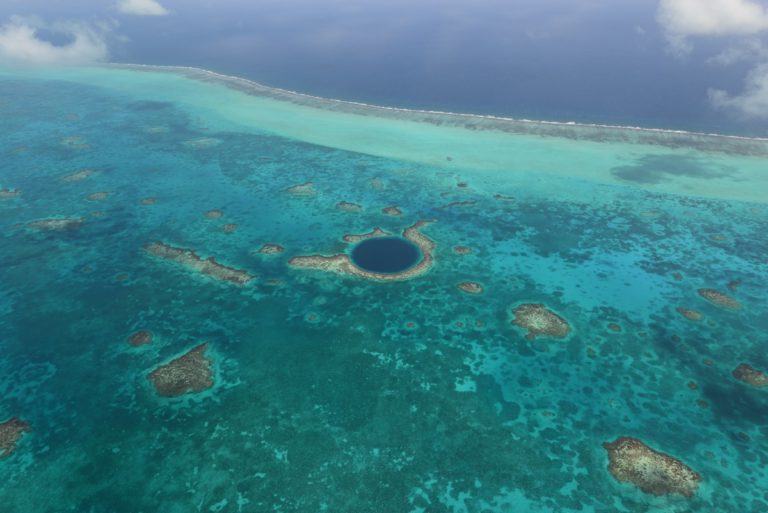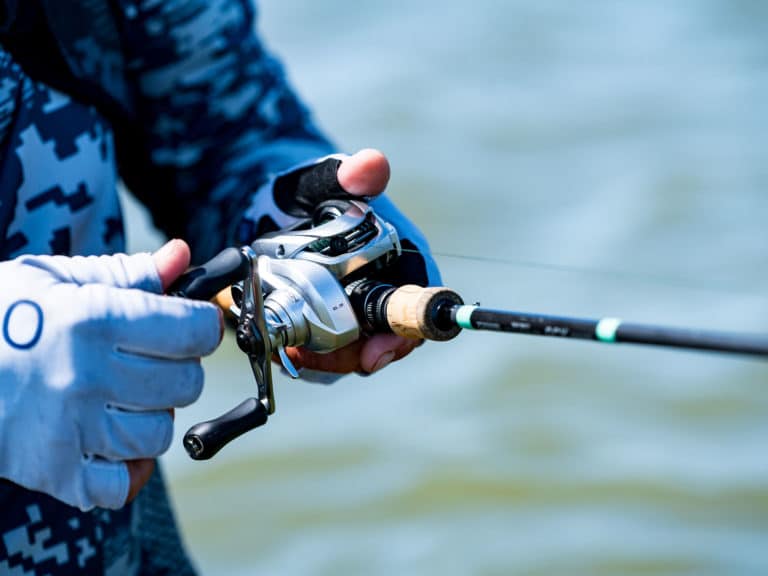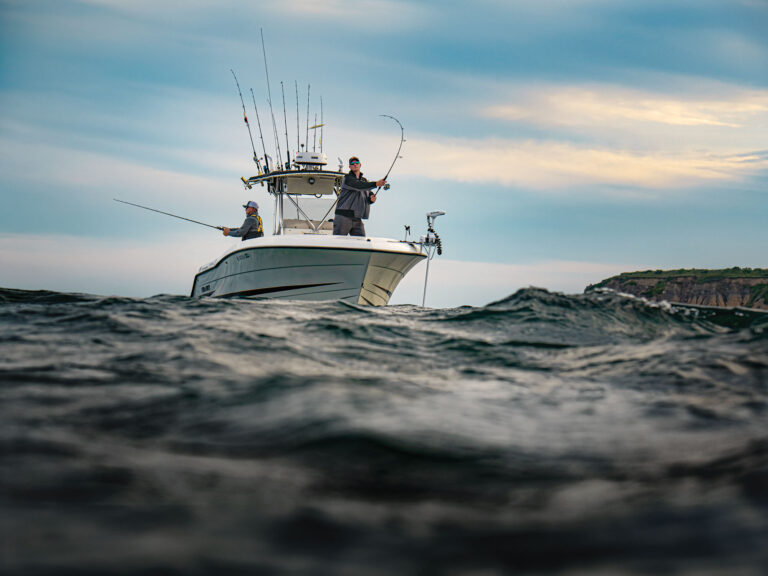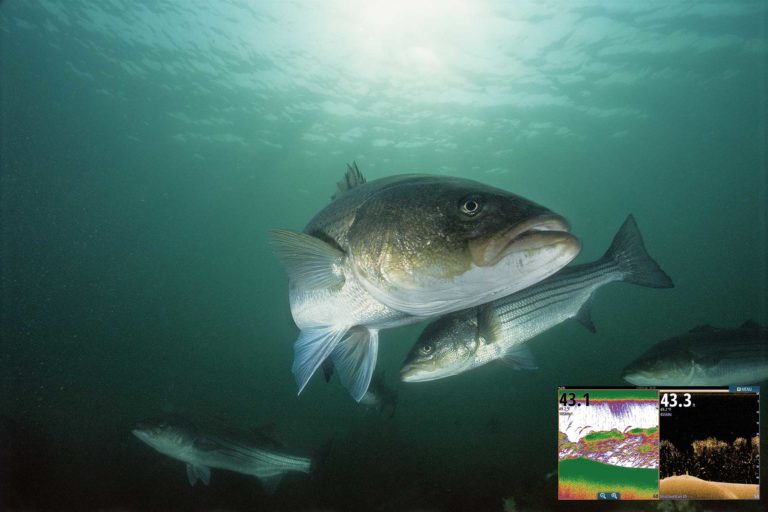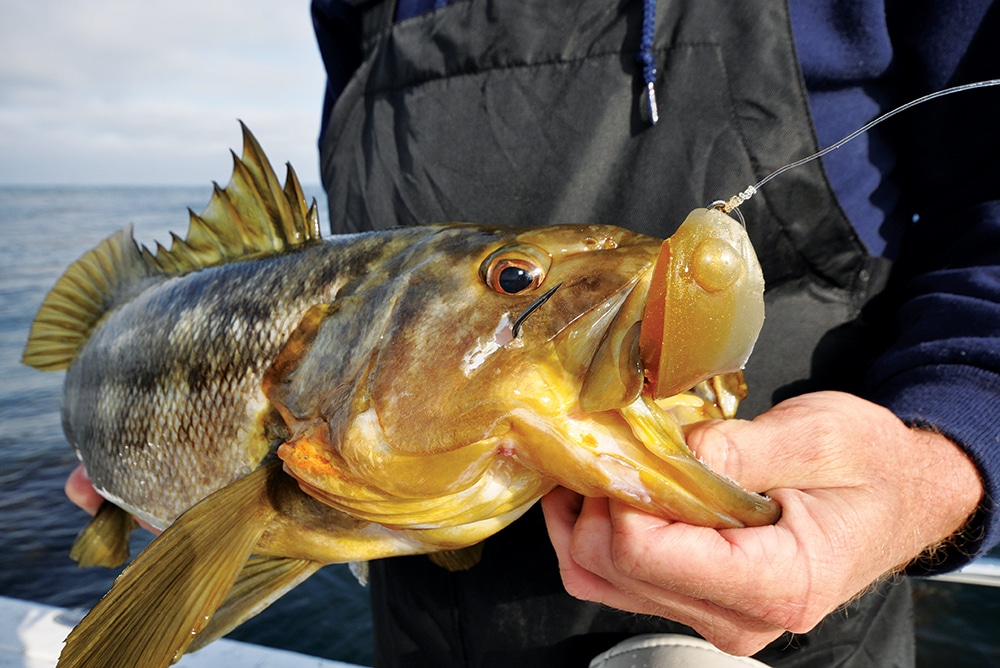
You’d have to search plenty of Florida Keys center-consoles to find one that didn’t have a few bucktails rigged for nearshore species. The jig-and-feather combo handles sharp teeth from mackerel and snapper, and survives rugged reef structures that pepper the East Coast and the Gulf of Mexico.
But head to Southern California, and you’ll notice another lure — one that anglers targeting calico bass swear by.
“Originally, we used a ‘bomber’ jig — a bullet-shaped lead-head, similar to a bucktail — and added squid,” says calico bass tournament angler Erik Landesfeind. “But eventually we moved away from the live and prepared baits. Fish weren’t responding to them, so we switched to swimbaits.”
This gave rise to a unique fishery for the aggressive calico bass along the rocky beaches and among the kelp beds of the California coastline and nearby islands.
“Using these baits and specialized gear, we’re fishing in areas once unable to be fished,” says Landesfeind. “In the past 15 years, bass tournaments have increased too. The Salt Water Bass Anglers tournaments now regularly register 50 to 70 boats. Each tournament, we’re breaking records — five-bass limits weighing up to 35 pounds.”
Swimbaits are established fish catchers, but they’re only as good as the angler makes them. No matter what species you target, consider these proven swimbait techniques as developed by two West Coast pros.
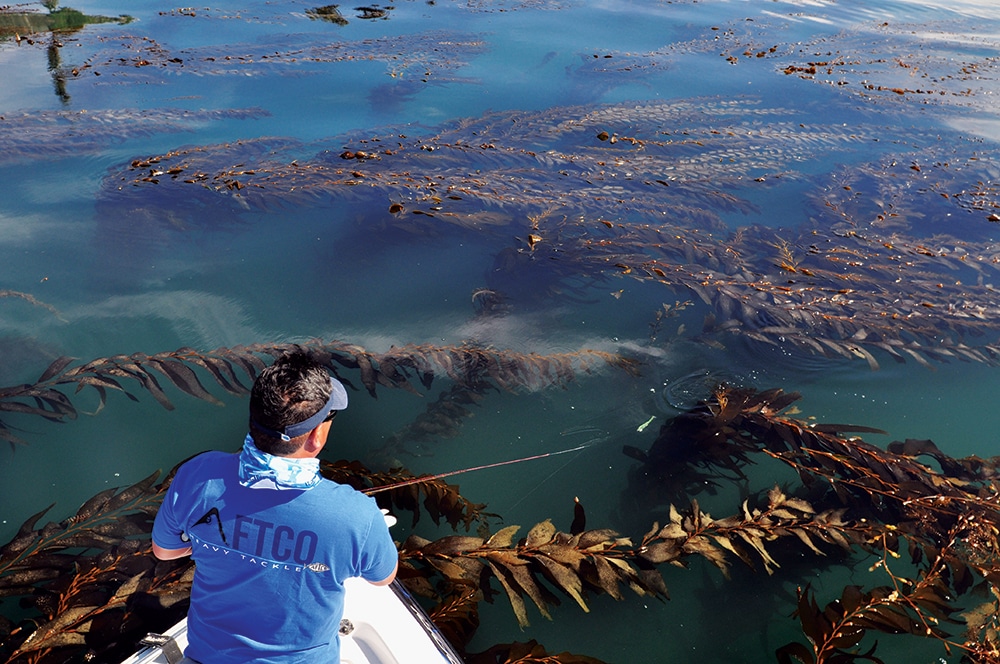
Help in the Kelp
Swimbaits are quickly trending as the go-to bait around kelp and near “boiler rocks” along beaches and islands such as San Clemente, Santa Barbara and Catalina. Around those boiler rocks wash frenzied waters where the swell meets the shore — and where bass use the washing-machine conditions to ambush baitfish.
“For kelp, current is key, and some current off the beach is good,” says Capt. Benny Florentino, who fishes as far up the coast as the Palos Verdes Peninsula and Santa Monica Bay. “Look for bait in slightly stained but not dirty water. I like fishing shallow, from 1 to 40 feet, especially when the bass are spawning in the summer.”
A kelp forest with stalks pointing straight at the surface indicates little or no current. Conditions improve when stalks have an obvious lean to them, showing some current. Calicos face into the current, usually at the leading edge of the kelp bed, says Landesfeind. On the other hand, too much current pushes the kelp away from the surface, and kelp bass don’t hang around in those conditions.
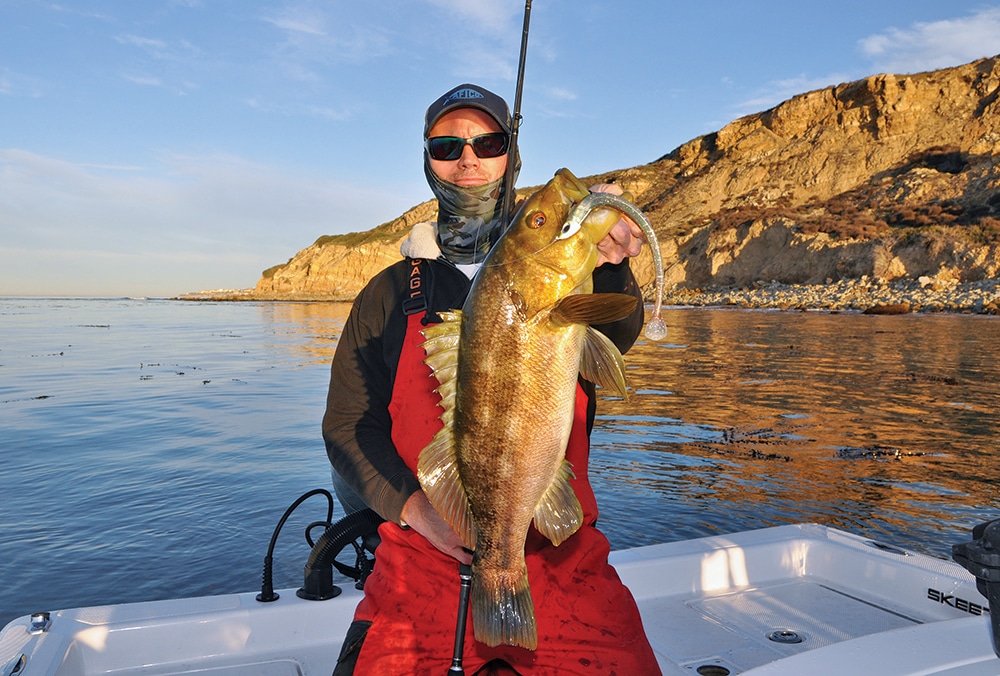
Swimbait Allure
Several lure companies on the West Coast specialize in soft baits for calico bass, including Big Hammer swimbaits, Fish Trap Lures and MC swimbaits. National companies also produce offerings like Berkley’s Jerk Shad, Storm’s WildEye patterns and Sebile’s weedless Magic Swimmer.
The soft bodies come in different molds, including paddle-tail and jerkbait styles. Florentino likes the darker browns, oranges and reds in the mornings, especially when the sky is overcast, but he’ll move to silvers and blues in the bright light of day.
“There are three ways I usually rig my swimbaits,” says Florentino. “On a lead-head, on a weedless head, or a weedless hook like an Owner or Trokar 9/0 or 10/0. A good weedless head is the Slayer Head from Warbaits — it’s built with a weed guard.”
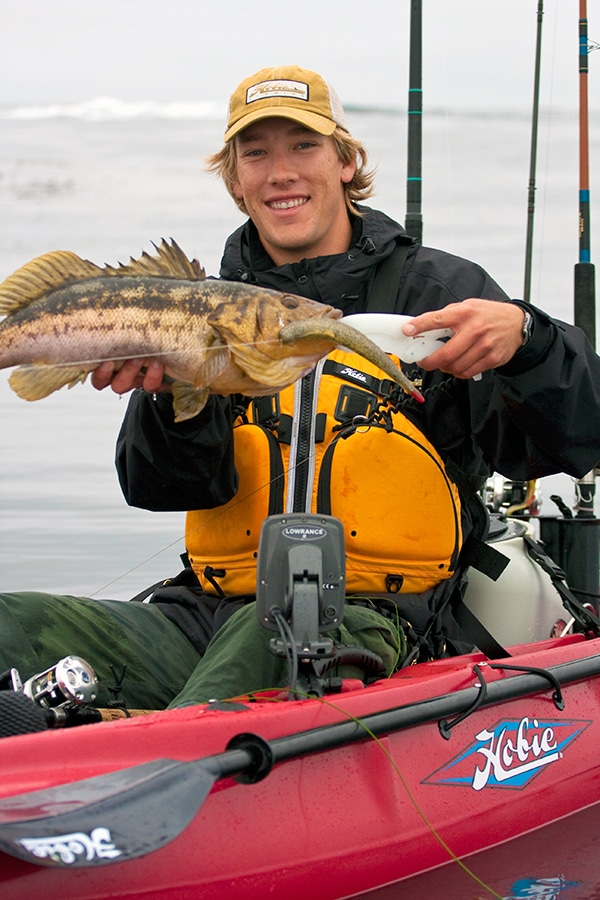
The soft baits tend to be long, especially when a 10-pound calico bass is considered a fish of a lifetime, and 5-pounder is a solid fish. Baits range from 4 to 9 inches, with the larger baits used to deter the smaller calicos. Still, sometimes it doesn’t work on these aggressive bass.
When fishing the kelp, cast to holes or open areas within the kelp, or use a weedless slug on top of the matted beds. Make sure the bait is not swimming up from behind the bass — it’s not a natural presentation.
“That topwater slug is a shadow — it’s visual,” says Landesfeind. “Below, I’ll also use the Viejo series from MC swimbaits because I believe the calicos feel that tight swimming vibration before they can see it. I’ve seen calicos charge baits they couldn’t have seen from far away.”
And watch out for those followers. That’s right — larger calicos often trail hooked bass to the boat. “These fish have no fear of the boat,” says Landesfeind. “I leave the big engine running as a safety precaution around the rocks and beach. But I always have a pitch bait ready — that’s how I’ve caught some of my bigger fish.”
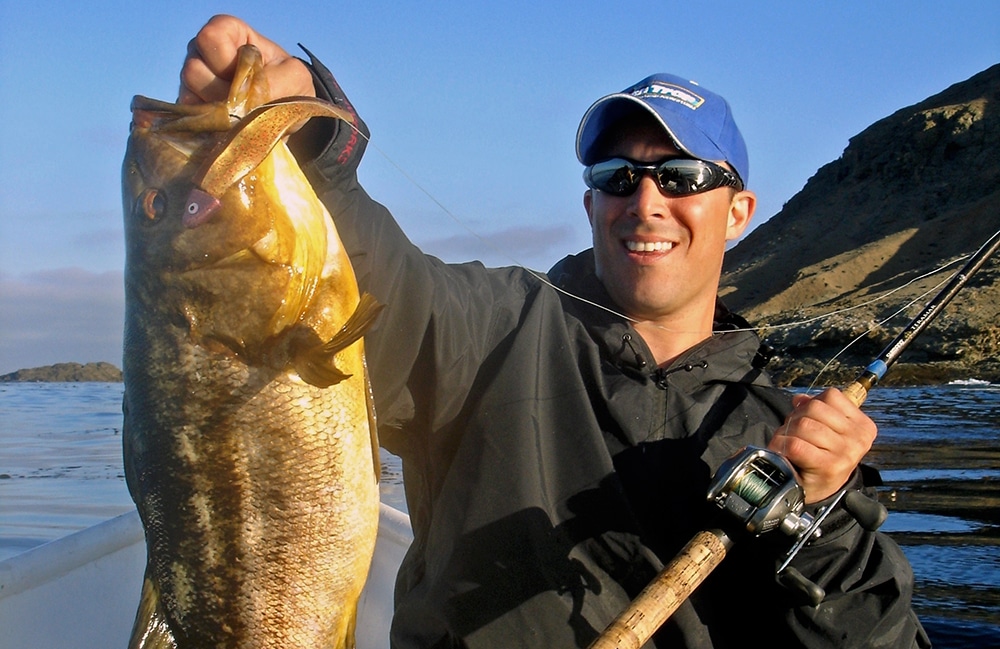
Tackle Right
For rods, most swimbait fishermen use beefed-up largemouth bass tackle — baitcasting trumps spinning gear. From talking with different West Coast anglers, there are a few reasons for this:
Many fishermen from long-range and day-trip boats have always used conventional tackle over spinning gear, so the transition was easy. It’ll be interesting to see if more swimbaiters start using spinning gear now that drag systems and gears have caught up to conventional reels, and in some cases, passed them.
Spinning gear is still perceived as amateurish among avid West Coast anglers because it doesn’t take as much “feel” to make a cast.
Freshwater bass fishermen transition fairly easily to saltwater bass. There’s no denying that these fresh- and saltwater species have similar feeding behaviors.
“We’re making precision short casts, up two to three casts a minute,” says Landesfeind. “We could make 800 casts in one day; I’m not worried about a backlash here or there.”
Florentino rigs his baitcasters with heavy braid from 50 to 65 pounds, often paired with a 7- to 8-foot rod, 50-pound fluorocarbon leader and a lead-head weighing 1 to 1¼ ounces.
“Braid cuts through the kelp,” says Florentino. “And a leader is good for rocky areas, though some anglers will tie the swimbait straight to the jig. With soft baits, use a steady retrieve back to the boat. Let the lure’s natural action do the work.”
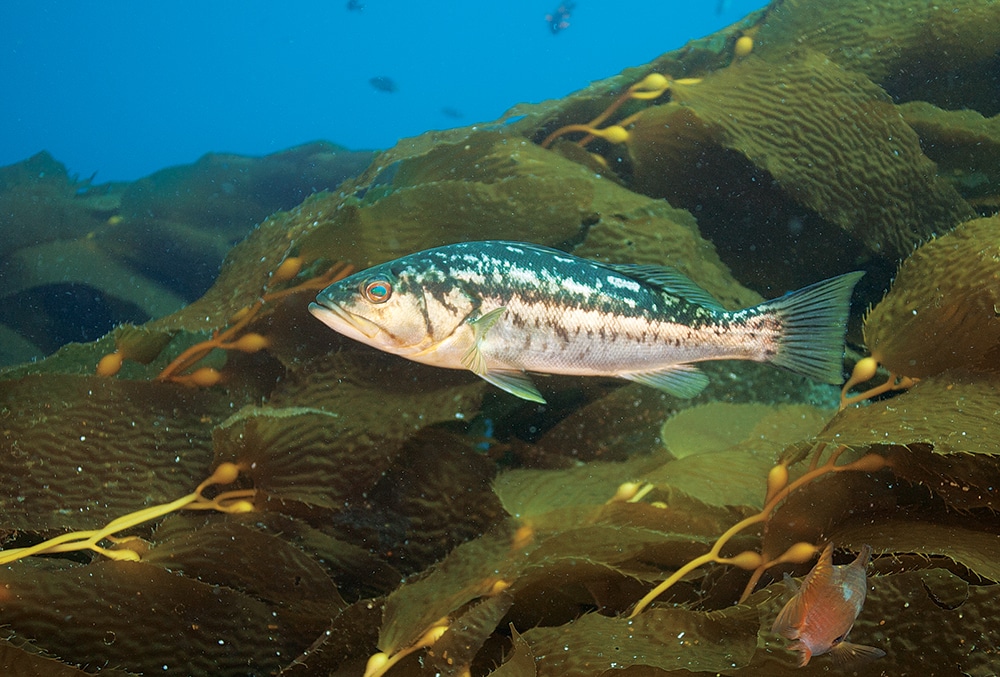
More Than Just Calicos
Swimbaits catch more than just calicos. Right around the kelp, anglers regularly catch yellowtail and white seabass that get much larger than bass. If you head inshore to the harbors and bays, barred sand and spotted bay bass are available to anglers throwing plastics. Here and north along the Pacific Coast, anglers use swimbaits in deeper waters to catch halibut, lingcod and rockfish.
“Smaller-size swimbaits — mostly 3 and 4 inches — are great for halibut in the surf zone,” says Pete Wolf, of Big Hammer swimbaits. “Fishing halibut from a float tube just beyond the surf is how I was introduced to swimbaits.”
Tuna fishermen also utilize swimbaits. Astute anglers fishing the “slide” on sport-fishing boats launch some of the same baits used for calico bass to marauding albacore, bluefin and yellowfin tuna. Once a fish is hooked on the troll, the captain slows the boat. That’s a prime opportunity for other anglers to cast swimbaits out behind the boat into the target zone. Let your line free-spool to allow the bait to drop in the water column, and there’s a solid chance a tuna will grab it.
Another tuna tactic is to troll a swimbait in the “stinger” position, says Capt. Barry Brightenburg of Fish Trap Lures.
“Use a 1½- to 2-ounce lead-head with a light-wire hook to troll a swimbait in the farthest-back position,” says Brightenburg. “That spot always seems to catch fish when nothing else is working.”
Who needs bucktails?


